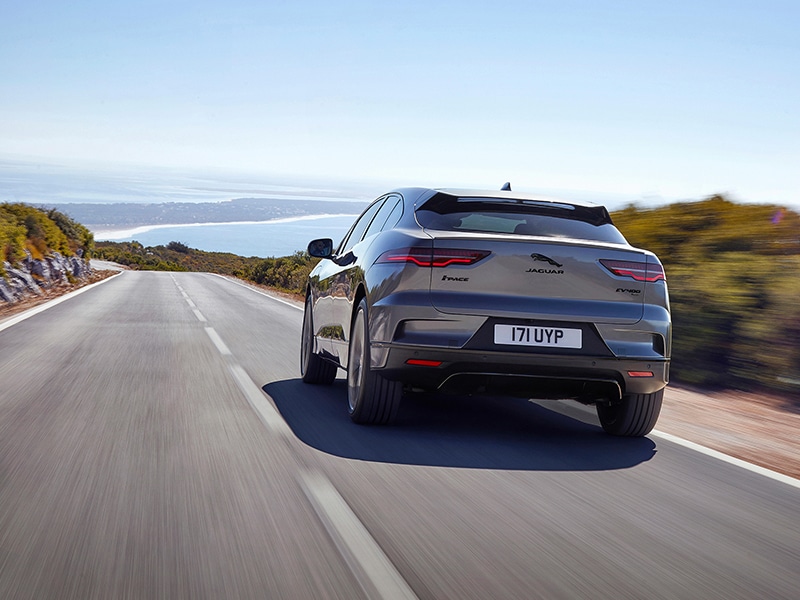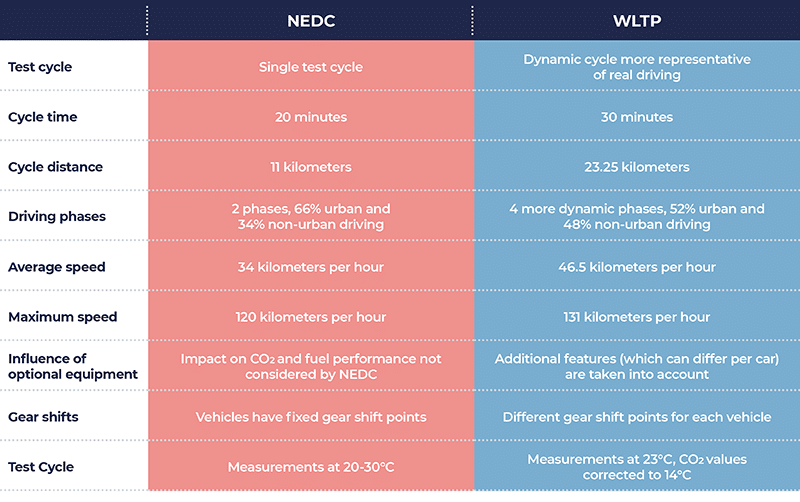
Source: Jaguar Land Rover
ANNOUNCEMENT from Dan Caesar, MD of Fully Charged: It’s difficult to quantify exactly how many Electric Vehicle purchases Robert Llewellyn’s Fully Charged has inspired over the last decade, but we suspect it is not an insignificant number. With more and more EVs on the market, and more ‘mainstream’ interest in switching to electric, we feel a growing responsibility to provide the most realistic range metrics available for Electric Cars.
While the NEDC (New European Driving Cycle) has now been succeeded by WLTP (Worldwide Harmonised Light Testing Procedure), we know from having driven every EV under the sun, that even these figures are optimistic.
In the early days, short-range EVs occasionally provoked over statement, but we do not believe newer buyers will tolerate exaggeration in the same manner that many early-adopters were prepared to.
As such, we intend to use ‘real-world’ range figures across our episodes from November onwards; although to ensure a consistency with the information that consumers receive from manufacturers, we will continue to quote WLTP figures too.
We are delighted then to announce that EV Database, a leading online source of electric car statistics with an audience of 450,000 unique visitors a month, is Fully Charged’s ‘Official Data Partner’.
In addition to ‘real-world’ range figures, EV Database also offers an array of statistics including price, acceleration, speed, efficiency, battery and charging details.
Here’s a blog from their founder, Arne Brethouwer, with an insight into the whys and hows behind the EV Database:
Real Range: what’s the actual range of an EV?
Advertised range of an EV almost never matches the actual day-to-day range, here’s why.
While experienced EV drivers will tell you range isn’t everything, it’s still clearly top-of-mind for the general public that’s now starting to adopt electric vehicles. Being such an important metric, it’s obvious that advertised range figures should be as accurate as possible. It’s not a great experience to find out that your brand new car doesn’t come close to the advertised range in practice. Unfortunately, this still happens to many EV buyers and it’s giving EVs a bad name. Why aren’t carmakers just advertising the real range of an EV? What actually is the ‘real range’ of an EV?
To answer those questions we need a bit of history. In the early days of EVs there was one test called the New European Driving Cycle (NEDC). Introduced in 1992, all NEDC tests were done in a lab under conditions that are nowhere near real life. Additionally, carmakers quickly started optimizing vehicles for these lab tests. The result: test figures started drifting from real life until the test became virtually useless. NEDC figures could be off by more than 50% in some cases.
A more realistic test was designed to replace NEDC. The new test is called ‘Worldwide Harmonised Light Vehicle Test Procedure’ (WLTP). The test is still done in a lab, but conditions have been modified to better reflect realistic driving conditions. WLTP was introduced in September 2017 and as of January 2021 it’s the only test figure a carmaker can advertise with.
Main differences between the two test procedures

Table 1: main differences between NEDC and WLTP. Source: wltpfacts.eu
The transition from NEDC to WLTP has resulted in some confusing situations. For example: some brands have been marketing NEDC figures that have been converted into WLTP and vice-versa. Some have been using them together, resulting in two very different figures for the exact same vehicle. And, as of today, some carmakers still use outdated NEDC figures in their marketing of brand new vehicles. As a bonus, the rules can differ by country. For example: Finland has been using WLTP since September 2018, while Spain and Italy will continue using NEDC until December 2020.
As of 2021 we should finally be in the clear: WLTP will have been fully adopted across Europe, with realistic range figures as a result. Unfortunately it’s not that easy. While WLTP provides some clear improvements over NEDC, it’s still far from ideal when it comes to the range an EV will have in the real world.
Let’s focus on the three most relevant issues with WLTP and why the resulting advertised range doesn’t match the real world:
Weather
Air temperature plays an important part in vehicle performance. I’ll skip the technical details, but it’s important to remember that lower air temperatures will result in lower range. The WLTP test is done at a steady 23 degrees celsius. That makes sense from a standardization perspective, but very few European regions actually have a 23 degree temperature year-round.
The other issue with temperature is climate control: WLTP tests are done without using any climate control. Cooling, and especially heating the cabin will greatly reduce the range of an EV.
And it’s not just air temperature. Other weather conditions will have an effect on vehicle efficiency too. Air pressure and wind can obviously have a significant impact, both positively and negatively. Additionally, precipitation – or rather wet road surfaces – will lower efficiency and range.
While it’s understandable that WLTP tests just use a fixed set of weather variables, it’s not how things are outside the lab.
Speed and driving style
As you can see from the comparison table, WLTP has a more aggressive speed profile compared to NEDC. However, the WLTP cycle still uses quite a defensive driving style. Average speed is only 47 km/h (29 mph) and acceleration is done at a very leisurely pace.
The main issue however, is that in the real world nobody will ever travel at these exact speeds. Some will mainly travel in and around urban areas, whereas others will mostly travel at motorway speeds for sustained periods of time. Some might drive aggressively, others might be more defensive. While a set speed cycle makes sense to standardize a lab test, it does mean that in practice virtually everybody will use the vehicle at completely different speeds and driving styles.
The second issue is vehicle/test compatibility. Some vehicles are designed to perform way outside the test speed profile, while other designs will fit the test almost perfectly. In practice, this means some vehicles can get much closer to their WLTP ranges on a daily basis than others.
Multiple WLTP ranges for one model
WLTP takes into account the influence of optional equipment. Stuff like larger wheels, spoilers or anything that adds weight to a vehicle will have an impact on range. It sounds benign, but just swapping out standard ‘aero wheels’ for more open and larger wheels with different tyres can impact range by as much as 5 to 10%.
As a result, a single model can have a wide range of WLTP ranges. Let’s take the Jaguar I-PACE as an example. It has an advertised WLTP range of 470 kilometers (292 miles). According to registration data from The Netherlands, as of 25 september 2020, a total of 4390 I-PACEs have been registered. Only 25 of those vehicles actually have the advertised WLTP range of 470 kilometers. On the other end of the spectrum, some vehicles have been registered with a WLTP range of just 411 kilometers (255 miles). That’s almost 13% lower than advertised. And that’s still just a WLTP figure, so before any of the real world factors have been taken into account.
In theory these ‘actual’ WLTP ranges should offer transparency to buyers. In practice this doesn’t really happen. Carmakers will market their vehicles with the highest WLTP range, not the lowest. The range will often be marketed as an ‘up to’ range, but that’s easily overlooked. PR departments will also list the highest range in their communications, which in turn leads to media presenting the highest possible WLTP range as ‘the range’ of a vehicle.
So, where does that leave us? As of 2021 all EVs will have an advertised range figure that still doesn’t give a clear picture of what to expect when actually using the vehicle. Simply reducing the advertised range by a fixed percentage doesn’t do much to get a clearer picture either. On some trips you might end up achieving only 50% of the advertised range, while on other trips you might match or even exceed the advertised range.
This is where our ‘EVDB Real Range’ figures might help out. Designed when NEDC was still the only test around, we decided to try and offer a better alternative to our users. While WLTP has its flaws, NEDC was simply becoming ridiculous. For example: the I-PACE has an NEDC range of 543 kilometers (337 miles). As this was the only range figure available, it was the only one we listed in the database. As a result, we started receiving complaints from users claiming we were intentionally misinforming them and that they’d never buy an EV again.
This really hit us where it hurts: our whole mission was to get as many people in a suitable EV as quickly as possible. Sometimes this also means an EV might not be a viable option yet, and that’s fine. But overpromising on range by such a wide margin was basically undermining our whole mission.
In order to better inform our users we currently provide 6 figures: city, motorway and combined ranges in both cold and mild weather (see table 2). Additionally, we provide a single ‘index figure’ in order to easily compare vehicles. The figures are based on a model that we’ve developed and fine tuned over the years. Modelled figures are verified in practice as much as possible and then fed back into the model to further optimize the results. This means that our figures will get more accurate over time.

Table 2: Real Range figures for Jaguar I-PACE EV400. Source: https://ev-database.org/car/1287/Jaguar-I-Pace-EV400
While these figures provide much more insight in what to expect in the real world, it still has quite a few flaws. All figures are still based on certain assumptions for weather, speed, road conditions, driving style, optional equipment etc. It does however achieve its goal: better informing our users and making them help an informed decision.
We’re working on further extending our models and verifications to give users more control and get even more accurate estimations for their specific situations. We’ll start including more specific speeds and weather conditions as well as other parameters. But even with all those optimizations, ‘Real Range’ will always be somewhat of a myth. There simply are too many variables and conditions that affect range at any given time.
Does this mean all these range figures are worthless? Absolutely not. Even WLTP ranges can still be useful. All vehicles are tested under the exact same lab conditions, so the resulting figures are fine as a general comparison between vehicles. It’s just not suitable to get a sense of what to expect during real use.
So, getting back to our question of why carmakers don’t advertise the real range of a vehicle: they simply can’t, as there is no such thing as a single real range figure. That said, advertised range, WLTP tests and how those resulting figures are being marketed clearly have lots of room for improvement.
If you’re looking for an EV, we’d suggest starting with our Real Range figures, as it’ll give a good reference to start from. Also, have a look at how the WLTP figures compare between vehicles that interest you. Be sure to check out range tests like Bjørn Nyland is doing, as he has tested a whole host of vehicles and properly documents all of them. And of course, keep watching the Fully Charged reviews for more insights. All these resources should give you a very clear picture of what to expect from a specific EV in real life.
Notes
- In all fairness to Jaguar: they do provide two WLTP ranges in their sales materials to reflect the fact that WLTP isn’t a single figure. In The Netherlands for example, Jaguar references a TEH (Test Energy High) of 407 kilometers and a TEL (Test Energy Low) of 470 kilometers. However, most brands aren’t as transparent and most potential buyers might not immediately the relevance of TEH and TEL.
About the author
Arne trained as a fighter pilot in the Dutch Air Force and studied Automotive Engineering. After more than 12 years as an e-commerce entrepreneur, he founded EV Database in 2016 to help move forward the transition to sustainable transport. By providing a comprehensive overview of all past, current and upcoming EVs the project aims to get as many people in a suitable EV as soon as possible.





